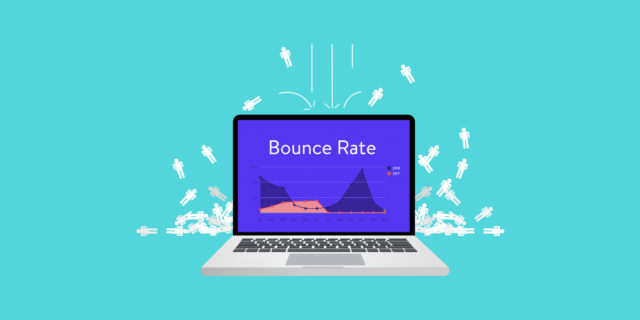A high bounce rate can signal to website owners that visitors are leaving their site quickly without engaging with the content. This can negatively impact your search engine rankings and hinder your overall online success. However, improving your bounce rate is not an insurmountable challenge. In this blog, we’ll explore effective strategies to enhance your website’s user experience, encouraging visitors to stay longer and engage more deeply with your content.

Table of Contents
ToggleWhat is Bounce Rate?
Bounce rate is the percentage of visitors who land on your website and leave without navigating to any other pages. A high bounce rate can indicate that your site is not meeting the expectations of your visitors, which can be caused by various factors, including poor design, irrelevant content, or slow loading times.
Understanding your bounce rate is crucial, but improving it can lead to better user engagement, higher conversions, and improved SEO performance. Here are actionable steps to lower your bounce rate and retain visitors.
1. Optimize Page Load Time
One of the most common reasons visitors leave a site is slow loading times. Research shows that users are likely to abandon a site if it takes more than three seconds to load. To improve page load times:
- Compress Images: Use image compression tools to reduce file sizes without compromising quality.
- Minimize HTTP Requests: Limit the number of elements on a page to decrease loading time.
- Utilize Browser Caching: Enable caching to store frequently accessed files and speed up loading for return visitors.
- Choose a Reliable Hosting Service: Invest in a reputable hosting provider that offers fast server response times.
2. Improve Mobile Responsiveness
With an increasing number of users accessing websites via mobile devices, ensuring your site is mobile-friendly is essential. A responsive design adapts to different screen sizes, providing a seamless experience for all users. To enhance mobile responsiveness:
- Use Responsive Design: Implement a design that adjusts fluidly to various screen sizes.
- Test on Multiple Devices: Regularly check how your site appears on different mobile devices and browsers.
- Simplify Navigation: Ensure that your menu is easy to use on smaller screens, and prioritize essential links.
3. Create Engaging and Relevant Content
Content is king, and it plays a vital role in keeping visitors on your site. If users don’t find the content engaging or relevant, they are likely to leave. To create compelling content:
- Know Your Audience: Understand the interests and needs of your target audience. Tailor your content to address their pain points and preferences.
- Use Captivating Headlines: Craft attention-grabbing headlines that entice visitors to read further.
- Incorporate Multimedia: Use images, videos, infographics, and other multimedia elements to make your content more engaging and easier to digest.
4. Optimize for SEO
Improving your search engine optimization (SEO) can help attract the right audience to your website. If your content doesn’t align with what users are searching for, they’re more likely to bounce. To optimize for SEO:
- Conduct Keyword Research: Identify relevant keywords and incorporate them naturally into your content.
- Optimize Meta Tags: Ensure your title tags and meta descriptions are compelling and accurately reflect the content on your page.
- Improve Internal Linking: Create a logical internal linking structure that guides visitors to related content, encouraging them to explore further.
5. Streamline Navigation
A confusing or complicated navigation structure can frustrate visitors and lead to high bounce rates. To create a user-friendly navigation experience:
- Use Clear Labels: Ensure menu items are clearly labeled and intuitive.
- Limit Menu Items: Avoid overwhelming users with too many options. Stick to essential categories that guide users effectively.
- Implement Breadcrumbs: Use breadcrumb navigation to help users understand their location within your site and easily backtrack if needed.
6. Add Clear Calls to Action (CTAs)
Effective calls to action (CTAs) guide visitors on what to do next, reducing bounce rates. To improve your CTAs:
- Be Clear and Specific: Use actionable language that clearly indicates what users should do, such as “Sign Up,” “Learn More,” or “Shop Now.”
- Position Strategically: Place CTAs in prominent positions where they are easily visible and accessible.
- Test Different Variations: Experiment with different wording, colors, and placements for your CTAs to see what resonates best with your audience.
7. Monitor and Analyze Visitor Behavior
Understanding how visitors interact with your site can provide valuable insights into areas for improvement. Use analytics tools like Google Analytics to track user behavior and identify patterns. Look for:
- High Bounce Rate Pages: Identify which pages have the highest bounce rates and analyze why.
- User Flow: Observe how visitors navigate through your site and where they drop off.
- Heatmaps: Use heatmap tools to see where users click, scroll, and spend the most time on your pages.
8. Leverage Social Proof
Social proof can significantly influence user behavior and reduce bounce rates. Displaying testimonials, reviews, or user-generated content can build trust and encourage visitors to stay longer. Consider:
- Showcasing Testimonials: Highlight positive feedback from customers prominently on your site.
- Incorporating Trust Badges: Display security seals, awards, or affiliations to enhance credibility.
- Using Case Studies: Share detailed case studies that demonstrate the effectiveness of your products or services.
Conclusion
Improving your website’s bounce rate is essential for creating a better user experience and achieving your business goals. By optimizing page load times, enhancing mobile responsiveness, creating engaging content, and leveraging analytics, you can significantly reduce bounce rates and foster deeper customer engagement. Regularly monitor your site’s performance, and be prepared to adapt your strategies as needed. With a commitment to continual improvement, you’ll not only lower your bounce rate but also create a more satisfying experience for your visitors, leading to increased conversions and long-term success.


No responses yet